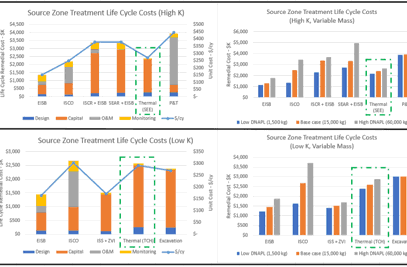Intro to Thermal Remediation
Welcome to our thermal soil remediation blog series! We're excited to share with you how we use heat to eliminate hazardous pollutants and create sustainable land. In this series, you'll learn about Thermal Conduction Heating, Steam Enhanced Extraction, and Electrical Resistance Heating. We'll provide you with expert insights, case studies, and resources to help you succeed in the field. Keep reading!
Your Comprehensive Guide to Understanding Thermal Remediation
Thermal remediation is a robust method that has been used to treat some of the world’s most heavily contaminated sites over the last two decades, but you may not be very familiar with it. Thermal reme...
Thermal Treatment of VOCs: A Proven Technique for Source Zone Cleanup
Have you ever wondered how a contaminant with a boiling point above 100°C can be volatilized and removed at temperatures near the boiling point of water? For example, one of the most common chlorinate...
The Basics of Thermal Remediation
Thermal remediation is a robust method that has been used to treat some of the world’s most heavily contaminated sites over the last two decades, but it may not be one you are very familiar with. In t...
Have You Ever Wondered How Much Energy It Takes?
How much energy is required during in situ thermal remediation (ISTR) project to reach site goals? It’s a question we often hear, because not only does energy usage impact project cost, it is als...
Is it Beneficial to Combine Thermal Technologies?
Maybe you have a site with challenging geological features, and you’re trying to figure out which remediation approach can handle all of them. Or perhaps you have a client who is on a tight schedule a...
7 Things You Need to Know About Safety on a Thermal Remediation Project
Thermal technology is powerful and rapid. The heat applied to the subsurface has the power to remove many types of contaminants from the subsurface, including VOCs, SVOCs, petroleum hydrocarbons, MGP ...
Answers to Your (Burning) Questions about In Situ Thermal Remediation
With so many options for remediation out there, can In Situ Thermal Remediation (ISTR) provide a solution for your site? And how do you know which thermal remediation approach is best? ISTR has three ...
Is Thermal Remediation Cost Effective?
“The successful completion of this project resulted in a cost avoidance of $218M by reducing the environmental remediation timeline by 140 years.” These words reflected on a recently completed Th...
What Is Electrical Resistance Heating (ERH) and How Does It Work?
When you are new to the thermal remediation industry, choosing the best technology can be overwhelming and confusing. Each heating technology has its own strengths and weaknesses depending on th...
What is In Pile Thermal Desorption (IPTD®)?
If you are not familiar with thermal treatment, then In Pile Thermal Desorption (IPTD®) is something you have probably never heard of before. You may be wondering, what is it? How does it wo...
An Introduction to Thermal Conduction Heating (TCH)
If you’re new to the environmental services industry, you may know about thermal remediation but not understand the differences between the different heating technologies. Each technology has its own ...
3 Key Things to Know About Vapor Monitoring at a Thermal Remediation Site
Vapor monitoring is a key component to any thermal remediation project, but it is subject to a unique set of challenges. For many contaminants, such as chlorinated solvents, typically more than 95% of...













